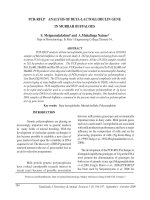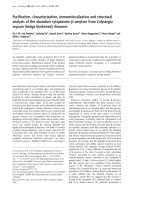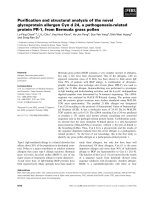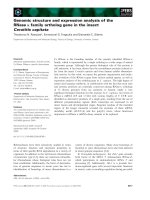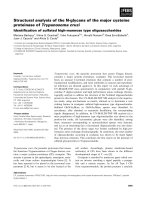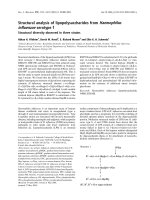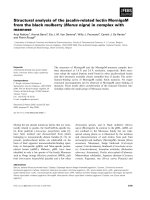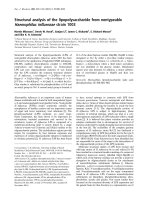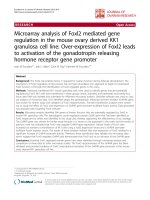Structural analysis of the rc gene in the local purple sticky yen bai rice variety
Bạn đang xem bản rút gọn của tài liệu. Xem và tải ngay bản đầy đủ của tài liệu tại đây (1.99 MB, 62 trang )
VIETNAM NATIONAL UNIVERSITY OF AGRICULTURE
FACULTY OF BIOTECHNOLOGY
-------oOo-------
UNDERGRADUATION THESIS
TITLE:
STRUCTURAL ANALYSIS OF THE RC GENE IN THE
LOCAL PURPLE STICKY “YEN BAI” RICE VARIETY
HANOI, 2022
VIETNAM NATIONAL UNIVERSITY OF AGRICULTURE
FACULTY OF BIOTECHNOLOGY
-------oOo-------
UNDERGRADUATION THESIS
TITLE:
STRUCTURAL ANALYSIS OF THE RC GENE IN THE
LOCAL PURPLE STICKY “YEN BAI” RICE VARIETY
Student
: Bui Thi Thanh Hien
Class
: K62CNSHE
Faculty
: Biotechnology
Supervisor
: Nguyen Quoc Trung, MSc.
Le Duc Thao, PhD.
HANOI, 2022
COMMITMENT
This thesis is composed of my original works, and contains no material
previously published or written by another person.
Hanoi, 20th March, 2022
Student
Bui Thi Thanh Hien
i
ACKNOWLEGEMENTS
During the process of studying, researching and completing the thesis, I
have received the help of many individual
First and foremost, I would like to express my gratitude to my supervisor
MSc. Nguyen Quoc Trung, Department of Molecular Biology, Vietnam
National University of Agriculture for their patience, motivation, and immense
knowledge. Their enthusiasm guidance helped me all the time of researching
and writing of this thesis.
My sincere thanks also go to teachers in the Faculty of Biotechnology,
Vietnam National University of Agriculture, whose encouragement, guidance,
and inspiration supported me during my studying time at higher education.
Besides that, I am thankful to my dear classmates, class K62CNSHE, for all the
time we had in the last four years.
Last but not least, I am grateful to my family and my friends for
supporting me spiritually throughout writing this thesis and my life in general
I sincerely thank you!
Hanoi, 20th March , 2022
Student
Bui Thi Thanh Hien
ii
CONTENT
COMMITMENT .................................................................................................. i
ACKNOWLEGEMENTS................................................................................... ii
CONTENT .......................................................................................................... iii
LIST OF TABLES .............................................................................................. v
LIST OF FIGURES ........................................................................................... vi
LIST OF ABBREVIATIONS........................................................................... vii
ABSTRACT ...................................................................................................... viii
INTRODUCTION ............................................................................................... 1
CHAPTER 1. LITERATURE REVIEW .......................................................... 3
1.1. Evolution and domestication of ricecultivar ................................................. 3
1.2. Purple sticky rice ........................................................................................... 6
1.3. Overview of anthocyanin .............................................................................. 7
1.4. Roles and characteristics of the Rc gene ..................................................... 11
1.5. Diversity of rice genetic resources in Vietnam ........................................... 15
1.6. Studies on phylogeny of Vietnamese local varieties ................................... 19
CHAPTER 2. MATERIAL AND METHODS ............................................... 22
2.1. Material ........................................................................................................ 22
2.2. Methods ....................................................................................................... 22
2.2.1. Total DNAextraction ................................................................................ 22
2.2.2. DNA fragmentamplification ..................................................................... 23
2.2.3. Sequencing and identification of gene model ........................................... 26
2.2.4. Sequence polymorphism analysis ............................................................. 26
2.2.5. Phylogenetic analysis ................................................................................ 27
CHAPTER 3. RESULTS .................................................................................. 28
3.1. Amplification and sequencing of Rc gene................................................... 28
3.2. Sequence Rc fragments................................................................................ 28
3.3. Structural analysis of Rc gene ..................................................................... 32
iii
3.3.1. Intron-exon structures : ............................................................................. 32
3.3.2. 14-base deletion detection: ....................................................................... 33
3.3.3. Sequence polymorphism of Rc gene......................................................... 35
3.4. Phylogenetic analysis .................................................................................. 36
3.5. Protein features ............................................................................................ 37
3.6. Sub cellular localization and 3Dmodel ....................................................... 38
CHAPTER 4. CONCLUSION AND SUGGESTION .................................... 40
CONCLUSION .................................................................................................. 40
SUGGESTION .................................................................................................. 40
REFERENCES .................................................................................................. 41
APPENDIX ........................................................................................................ 43
iv
LIST OF TABLES
Table 2.1. Component of the PCR reation .......................................................... 24
Table 2.2. List of 18 primer pairs for amplifying DNA fragments of Rc gene. . 25
Table 2.3. Rc gene sequences of 8 accessions from the NCBI. .......................... 27
Table 3.1. Physical and chemical parameters of protein of NepCam YB with 8
reference varieties. .............................................................................................. 38
v
LIST OF FIGURES
Figure1.1.The evolution of rice (Purugganan 2010) ............................................. 4
Figure1.2. Awns of wild and cultivated rice. ........................................................ 5
Figure 1.3. 28 samples of rice varieties after husking .......................................... 7
Figure 1.4. Basic anthocyanin structure (Khoo, Azlan et al. 2017) ..................... 8
Figure1.5. Different R radicals of anthociadin (Chaves-Silva, Dos Santos et al.
2018) ...................................................................................................................... 9
Figure 1.6. Metabolic pathways for the synthesis of pro‐anthocyanidins and
anthocyanins (Chaves-Silva, Dos Santos et al. 2018) ........................................ 10
Figure 1.7. Genetic diversity of rice color. ......................................................... 11
Figure 1.8. Rc allele phenotypes (Sweeney, Thomson et al. 2006) .................... 13
Figure 1.9. Population structure and location of the Indica and Japonica
subpopulations within Vietnam. (Higgins, Santos et al. 2021) .......................... 20
Figure 1.10. Population structure and location of the Indica and Japonica
subpopulations within Vietnam. (Higgins, Santos et al. 2021) .......................... 21
Figure 2.1. Rice grain of NepCam YB ................................................................ 22
Figure 3.1. Electrophoresis photo of Rc gene fragments amplified by PCR (DNA
ladder was KAPPA universal ladder 100 bp) ..................................................... 28
Figure 3.2. Part of the gene sequencing results expressed through Chromas software
............................................................................................................................. 29
Figure 3.3. Full sequence of NepCam YB .......................................................... 32
Figure 3.4. Exon intron structure of Nepcam YB. .............................................. 33
Figure 3.5. Collinear analysis of the fifth intron's partial sequence of Rc .......... 33
Gene of NepCam YB. ......................................................................................... 33
Figure 3.6. The SNPs in RC gene of NepCam YB compared with 8
representative rice accessions. ............................................................................ 35
Figure 3.7. G-C content, A-T content chart of each variety. .............................. 35
Figure 3.8. Phylogenetic tree of Nepcam YB with 8 rice varieties. ................... 37
Figure 3.9.Model structure Rc of each variety. ................................................... 39
vi
LIST OF ABBREVIATIONS
bHLH
basic helix-loop-helix
BC
Before Century
AD
Anno Domini
QTL
Quantitative trait locus
FNP
Functional nucleotide polymorphism
ABP
Anthocyanins biosynthesis pathway
DFR
PCR
Dihydroflavonol-4-reductase
Polymerase chain reaction
vii
ABSTRACT
Rc is one of the most important regulatory genes for proanthocyanidin
accumulation in the rice pericarp. A study on mutation and sequence
polymorphism of the Rc gene will provide evidence for understanding
anthocyanin synthesis and evolution of rice cultivars. The aim of this study was
to a Rc hive a full-length genomic DNA sequence and analyze polymorphism in
the Rc gene of Nepcam YB variety, a local pigmented rice in Yen Bai province.
By using 18 primer pairs, full- length sequence along with down-stream and upstream segment of the Rc gene was successfully assembled and aligned by
BioEdit software with 7500 bp. We found that the Rc gene from NepCam YB
variety contains 8 introns and 9 exons. Sequence polymorphism analysis has
revealed 14 bp deletions in the fifth introns and 54 SNPs was detected by
comparing with 8 representative rice cultivars. Identification of physicochemical
parameters of Rc protein showed hydrophilic and unstable properties. The Rc
protein was determined to be located in the mitochondria. Phylogeny analysis
revealed close relationship of Nepcam YB with japonica Jefferson cultivar. In
this study, full-length sequence of the Rc gene in Nepcam YB variety was
successfully sequenced and is preliminary data for further study on
domestication of Vietnamese localrice.
Keywords: Proanthocyanidin, pigmented rice, gene model, SNPs, phylogenetic
tree, Rc gene.
viii
INTRODUCTION
Introduction
Rice (Oryza sativa) has been considering as one of the most important
cereal crops that is widely cultivated in Asia and has a long domestication
history. Rice is a staple food of more than 100 countries as the main
carbohydrate source for more than half of the global population. A large number
of rice varieties, including wild and cultivated rice plants, have been obtained in
the world, of which they were varied on grain properties, like shape, amylose
content and pericarp color. Among them, pericarp color, caused by the high
accumulation of non- Chl pigments (like anthocyanins, flavanols and proanthocyanidins), was noted as a rare characteristic of rice plants. According to,
the color of rice pericarp was varied from red (from weedy rice), purple (purple
rice), brown (brown rice) and white (cultivated rice). Therefore, it would be very
interesting to get insight into the purple sticky rice.
In Vietnam, purple sticky rice is a specialty rice variety that has been
grown for a long time, in many localities, in many different ecological regions,
and is very diverse in phenotypes. Products made from purple sticky rice are
used for many different purposes in people's lives; purple sticky rice is present
in many festivals. That creates bearing Vietnamese cultural identity. However,
studies on anthocyanins at molecular level in Vietnamese purple sticky rice are
still limited, making it difficult to exploit and use native genetic resoues Rc.
Rc has been well-characterized as one of the most important regulatory
genes in the pathway of proanthocyanidin accumulation in the rice pericarp.
Briefly, Rc locates on rice chromosome 7, contains eight exons, and encodes a
basic helix-loop-helix (bHLH) regulatory protein. The major Rc domestication
allele which has been occurred in more than 97% of non-pigmented rice
cultivars, is characterized by a 14-bp fragment deletion in the seventh exon. This
mutation generates a truncated, non-functional gene product and the non-
1
pigmented („white‟) pericarp of the domesticated rice. An independently
evolved domestication allele, Rc-s is found in other white pericarp rice
genotypes with the frequency of less than 3% and exhibits a base transversion
(i.e., C to A) in the seventh exon instead of the absence of a 14-bp fragment.
The aim of this study was to analyze the sequence polymorphism in Rc
gene of Nepcam pigmented YB rice, a local cultivar in Yen Bai province,
Vietnam.
Objectives
The objectives of this study were to analyze the sequence polymorphism
and structural properites of Rc gene to reveal phylogeny of Nepcam pigmented
YB rice, a local cultivar in Yen Bai province, Vietnam.
Requirements
Optimization of PCR conditions for cloning 18 Rc gene fragments.
Sequencing18 gene fragments and assembly full sequence of the Rc gene.
Sequence and structure analysis of Rc gene in NepCam YB.
Construction of phylogenetic tree of NepCam YB. rice based on full
length sequence of Rc gene.
2
CHAPTER 1. LITERATURE REVIEW
1.1. Evolution and domestication of ricecultivar
Rice has been known as the world‟s largest food crop, providing the
caloric needs of millions of people daily. Rice belongs to genus Oryza of family
OryzaGramineae that consists of 21 wild-types of the domesticated rice varieties
(Vaughan et al. 2003). The O.sativa genus is divided into four species
complexes, namely O. sativa, O.officialis, O.ridelyi and O.granulata.
The O. sativa complex contains two domesticated species, including
O.sativa and O.glaberrima, are the only cultivated species grown worldwide,
and in some parts of West and Central Africa, then, six wild-types, including
O.rufipogon, O.nivara, O.barthii, O.longistaminata, O.meridionalis and
O.glumaepatulaare fit into O.sativa complex. O.sativa is distributed globally
with a high concentration in Asia, while O.glaberrima is grown in West Africa.
O.rufipogon can be found throughout Asia and Oceania. Oryza barthii and
O.longistaminata are African species, O.barthii endemic in West Africa and
O.longistaminata is found throughout Africa. Oryza meridionalis is native to
Australia and O.glumaepatula is endemic in Central and South America. Based
on these distributions, it is easy to locate the ancestral pools from which modern
rice
was
extracted. The African
cultivars
were domesticated
from
O.breviligulata and O.sativa was domesticated from O.rufipogon.
Based
on
the
previously
presented
evidence
of
independent
domestications for indica and japonica, the researchers made some crosses
between the two subspecies, the offspring should segregate for wild alleles at
several loci and wild characteristics should re-appear among sub-specific
populations. Most notably for traits like dormancy and shattering, intra-specific
crosses between parents with low dormancy and shattering give rise to progeny
that has higher levels of dormancy and shattering than either parent (Lin et al.,
1998; Miura et al., 2002; Longbiao et al., 2004; Konishi et al., 2006). However,
3
levels of dormancy and shattering in these crosses are not as high as wild
accessions, suggesting either that indica and japonica share some domestication
alleles or that independent mutations within the same domestication loci
occurred in each subspecies which fail to compliment when crossed. Another
confirmation that different domestication genes were under selection in different
subpopulations comes from QTL studies. Populations derived from crosses
between a single wild accession and diverse cultivars often identity different
QTLs for domestication traits (Xiao et al., 1998; Moncada et al., 2001;
Septiningsih et al., 2003; Thomson et al., 2003; McCouch et al., 2006; Xie et
al., 2006)
Figure1.1.The evolution of rice (Purugganan 2010)
According to Cao et al. 2006, 4000 BC, rice grains sieved from the oldest
known paddy fields in the lower Yangzi River Valley, giving clear-cut evidence
for rice cultivation at this point in time. Genetic changes causing the shift from
wild to domesticated rice are harder to pinpoint. Mutations leading to a
reduction in the degree of grain shattering are a prerequisite for domestication.
4
Wild grasses are mean little things; for example, the seeds of many wild
grass species have awns, large, barbed spikes that can fend off seed-eating
animals, assist in seed dispersal, and help plant the seeds. In Triticum spp,
changes in humidity cause the awns to flex, which can help bury the seeds. After
thousands of years of artificial selection, our domesticated cereal crops have
shorter or nonexistent awns to facilitate grain harvesting, handling, and storage.
Rice Oryza sativa domestication also involved alterations in many traits,
including growth habit, seed shattering, panicle architecture, grain size, and hull
color (Sang and Ge,2013).
Figure1.2. Awns of wild and cultivated rice.
(A) shows the panicles of wild rice
(left) and domesticated rice (right), bar¼
¼
10cm; (B) shows the seeds of wild rice (top) and a domesticated rice (bottom),
bar¼ 1cm; (C) shows the surface of a wild rice awn (left) and a domesticated rice
awn (right) under a scanning electron microscope, bar 200mm. (Hua et al.2015)
The wild progenitors of cultivated rice were O.nivara and
O.rufipogon, two most closely related wild species with the current
distribution from southeastern Asia to India.O. nivara was often regarded as
an annual ecotype of O. rufipogon in the literature partly because the correct
identification of the species was not always possible or reliable for seeds
distributed from the germplasm centers. Nevertheless, the two taxa are
5
morphologically, physiologically, and ecologically distinct in the natural
habitats, experimental field, and green houses.O. rufipogon, adapted to the
stable, deep-water habitat, is perennial, predominantly out crossing, and
photoperiod sensitive. O.nivara was derived from O.rufipogon by adapting
to the seasonally dry habitat in regions with a clear monsoon season. In order
to promptly complete the life cycle in the unstable habitat, O.nivara went
through a series of adaptive steps and became an annual, self- fertilized, and
photoperiod insensitive species (Sang and Ge 2013), (Grillo, Li et al. 2009).
1.2. Purple sticky rice
Purple sticky rice is a type of the rice species Oryza sativa L., which is
glutinous, packed with high level of nutrients and mainly cultivated in Asia.
Purple sticky rice, as one would imagine, is deep purple in color. The purple
color is due to the grain‟s naturally high anthocyanin content, a trait most
typically observed in fruits such as blueberries. Purple sticky rice has dark
purple hues in its outer bran layer that are so intense that the rice appears to be
black. Once cooked, the color lightens into that same deep purple/violet. This
dark purple color predominantly comes from anthocyanins which are flavonoids
that perform as antioxidants in the body.
Purple sticky rice includes several varieties with a long history of
cultivation in Southeast Asian countries such as China, India and Thailand
(Kong et al. 2008). There are more than 200 types of purple sticky rice varieties
in the world. Only China is responsible for 62 % of global production of purple
rice and it has developed more than 54 modern purple rice varieties with high
yield characteristics and multiple resistances. China cultivates the most purples
rice followed by Sri Lanka, Indonesia, India and Philippines etc. Thailand
occupies the ninth position to purple rice cultivation (Ichikawa et al. 2001).
Interest in purple rice is indicated by the number of accessions held in
germplasm collections, e.g. China–359, Sri Lanka–50, Indonesia– 42, India–30,
the Philippines–25 and Bangladesh–24 (Chaudhary 2003). Nutrients such as
6
protein, minerals (Ca, P, Fe, and Zn) and dietary fiber contents are higher in
purple rice compared to brown and white rice. Demand for this rice is growing
fast in the USA and European countries due to its value as a healthy food and its
attractive organic food color. Purple sticky rice is surely a special breed of rice
that is cultivated on earth. This rice is getting popular in recent years because of
its high nutritive value and ant-oxidative properties.
In Vietnam, purple sticky rice is a traditional rice variety that responds to
short day light. Therefore, only one crop can be grown in the year and is grown
mainly in the northwestern mountains such as Hoa Binh, Son La, Yen Bai
scattered in other areas such as Phu Tho, Ninh Binh and the Mekong Delta with
2 provinces are Long An and Can Tho.
Figure 1.3. 28 samples of rice varieties after husking
1.3. Overview of anthocyanin
Most rice (Oryza sativa) that is grown and consumed throughout the
world has white pericarp, but rice can also produce grains with brown, red, and
purple pericarp. Here, two genes affecting proanthocyanidin synthesis in red and
brown‐ colored rice was elucidated were Rc gene and Rd gene. Especially, Rc is
a domestication-related gene required for red pericarp in rice.
7
The anthocyanins, a relatively small group of pigments in the diverse
flavonoid family, are largely responsible for the red-blue coloration in a large
number of plant species worldwide. Their occurrence in fruits and flowers seem
to offer clear benefits in attracting pollinators and aiding seed dispersal.
Anthocyanins are the largest group of phenol pigments and the most
important group of water-soluble pigments in plants (He et al. 2010),
responsible for the red, purple and blue colors found in many fruits, vegetables,
cereal grains and flowers, being odorless and nearly flavorless and contributing
to taste as a moderately astringent sensation. Anthocyanins are almost
universally found in higher plants (occurring in about 30 families), but in
general anthocyanins seem to be absent (Gould et al. 2008) in the liverworts,
algae and other lower plants, although some of them have been identified in
mosses and ferns. Anthocyanins are found mainly in the skin, except for certain
types of red fruit (He, et al. 2010).The distribution of anthocyanin in purple rice:
Anthocyanin compound appears to be mainly associated with the bran layer of
rice (Chen et al. 2012).
Figure 1.4. Basic anthocyanin structure (Khoo, Azlan et al. 2017)
8
Figure 1.5. Different R radicals of anthociadin (Chaves-Silva, Dos Santos et
al. 2018)
The red pigment in rice grains is proanthocyanidins, also known as
concentrated tannins (Oki et al., 2002). Proanthocyanidins are a branch of the
anthocyanin pathway and share many of the same biosynthetic genes (WinkelShirley, 2001). Proanthocyanidins have been shown to have important inhibitory
effects on pathogens and predators. The different anthocyanin anthocyanidins
are due to different R radicals (Figure1.5).
Anthocyanins are formed from chemical raw materials in purple rice and
also the whole plant, using the amino acid phenylalanine, or another chemical
called malonyl coenzyme A. These two substrates join to form the base material
for anthocyanins called "chalcones" that lead to the production of anthocyanins
after a series of enzyme steps. The parent material of anthocyanins is a group of
similar structures named "anthocyanidins "or" proanthocyanidins" which contain
no sugar molecules.
9
Figure 1.6. Metabolic pathways for the synthesis of pro‐ anthocyanidins
and anthocyanins (Chaves-Silva, Dos Santos et al. 2018)
Mutations with novel anthocyanin and proanthocyanidin expression
patterns can be easily identified by genetic analysis. The anthocyanin
biosynthetic pathway (ABP) is one of the most widely studied pathways of
secondary metabolism in plants, and most genes encode enzymes for this
biosynthetic pathway were isolated (Figure 1.4). The activities of genes involved
in anthocyanin biosynthesis are largely regulated and determined at the
transcription.
Anthocyanin is a natural colorant with many valuable properties and
effects, so it is increasingly used in the food industry as well as in medicine. In
food production, together with other natural colorants such as carotenoids,
chlorophyll, anthocyanin help products restore their original natural color,
creating attractive colors for each product. At the same time, due to their
antioxidant capacity, they are also used to stabilize fats. In the food industry,
natural anthocianin is a source of color of great significance because it does not
10
cause complications for humans, has a bright color, especially in the red area,
and is easily soluble in water, so it can be easily mixed in color. Food products
such as: coloring candy, soft drinks ... without causing toxicity. Anthocyanin is a
polar natural organic compound, which dissolves well in polar solvents. In
addition to creating beautiful colors, anthocyanins also help the body fight a
number of diseases such as: anti-cancer, anti-inflammatory, antioxidant.
1.4. Roles and characteristics of the Rc gene
Plant coloration is determined mainly by three types of plant pigments
besides chlorophyll: anthocyanins, betalains, and carotenoids, which function
in photosynthesis , defense, and reproduction (Tanaka, Sasaki et al. 2008).
Anthocyanins, a major subclass of
flavonoids, are the main secondary
metabolites that give color to rice tissues (Reddy, Dash et al. 1995).
Anthocyanin accumulation in plants has diverse functions, including resisting
UV radiation, participating in hormone regulation, and responding to biotic and
abiotic stress, and is beneficial to human health (Koes, Quattrocchio et al. 1994).
In rice, anthocyanins color tissues and give them various functions (Figure1.7).
Figure 1.7. Genetic diversity of rice color.
(a) Rice pericarp color diversity from white, light red, red, and brown to black.
(b) Rice seed color diversity. Left side shows seed morphology and right side
11
the corresponding grain morphology. (C–f) Leaf (c), apiculus (d), stigma (e),
sheath and stem (f), and plant (g) color diversity.
Most rice (Oryza sativa) grown and consumed around the world
contains rice bran husk is white, but rice can also produce brown, red, and
purple rice bran kernels. The color is visible when the seed is shelled, but it can
be removed by polishing to reveal the white endosperm. Red pericarp is
ubiquitous among the wild ancestors of cultivated rice (Oryza rufipogon), and in
some parts of the world the red variety is favored for its flavor, medicinal value
(Sweeney, Thomson et al. 2006)... The Rc gene is found in most white rice bran
rice genotypes and the absence of the 14 bp fragment of white grain rice
varieties found around the world today suggests that This gene was dispersed
during the early stages of domestication and disseminated by either origin in
modern varieties or a strong, positive selection for the allele leading to its
perpetuity in genetic resources. But rice can also produce brown, red, and purple
rice bran grains. Here, (Sweeney, Thomson et al. 2006) two genes affecting
proanthocyanidin synthesis in red and brown rice have been elucidated, namely
the Rc gene and the Rd gene. Two loci were identified using classical genetic
analysis. When present together, these loci produce red seed color (Kato
&Ishikawa, 1921). Rc in the absence of Rd produced brown seeds, while Rd
alone had no phenotype (Figure 1.8).
12
A
B
Top row: seeds from cv Jefferson (A)
and O. rufipogon (B).
Bottom row: seeds from Surjamkuhi (C)
and H75 (D).
C
D
Figure 1.8. Rc allele phenotypes (Sweeney, Thomson et al. 2006)
Rc is a domestication-related gene required for red rice bran husk in rice
(Oryza sativa), where it is strongly associated with seed breakage and
dormancy, red rice bran husk in rice does not have a 14 bp deletion in the Rc
locus. Rc encodes a basic helix-loop-helix (bHLH) protein that was well mapped
to the 18.5 kb region on rice chromosome 7 using a cross between Oryza
rufipogon (red rice bran husk) and O. sativa Jefferson (white rice bran husk)
(Sweeney, Thomson et al. 2006). Sequences of alleles from both the mapping
parent as well as from two independent Rc gene sources suggest that the red
dominant allele differs from the white recessive allele by a 14 bp deletion in
exon 6 that removes the bHLH of the extracted protein (Sweeney, Thomson et
al. 2006). An early stop codon was identified in the second mutant herd with a
light red shell. RT-PCR experiments confirmed that the Rc gene was expressed
in both red and white rice but a truncated copy was present in the white rice
varieties. The appearance of red or brown color in rice husk is determined by the
complementary effect of two genes Rc and 17 Rd. The RcRd and Rcrd genotypes
produced red and brown rice bran husks, respectively. In contrast, the rcRd and
rcrd genotypes produced a white colored pod (Nagao 1947). Pro-anthocyanidins
13
have been identified in rice bran husks RcRd and Rcrd (Nagao 1947), suggesting
that Rd and Rc loci are involved in proanthocyanidin synthesis. These
observations raise the possibility that rd is not an empty (loss of function)
mutant, but a conditional mutation. This is because intermediates of
proanthocyanidin synthesis seem to accumulate in Rcrd granules, resulting in
the appearance of a brown color.
Different colors, such as purple, brown, red and white, occur in the
pericarp of rice. Here, two genes affecting proanthocyanidin synthesis in redand brown-colored rice were elucidated. Genetic segregation analysis suggested
that the Rd and A loci are identical, and both encode dihydroflavonol-4reductase (DFR). The introduction of the DFR gene into a Rcrd mutant resulted
in red-colored rice, which was brown in the original mutant, demonstrating that
the Rd locus encodes the DFR protein. Accumulation of proanthocyanidins was
observed in the trans for mants by the introduction of the Rd gene into the
rice Rcrd line (Furukawa, Maekawa et al. 2007). Protein blot analysis showed
that the DFR gene was translated in seeds with alternative translation initiation.
A search for the Rc gene, which encodes a transacting regulatory factor, was
conducted using available DNA markers and the Rice Genome Automated
Annotation System program. Three candidate genes were identified and cloned
from a rice RcRd line and subsequently introduced into a rice rcrd line. Browncolored seeds were obtained from transgenic plants by the introduction of a gene
containing the basic helix–loop–helix (bHLH) motif, demonstrating that
the Rc gene encodes a bHLH protein. Comparison of the Rc locus among rice
accessions showed that a 14-bp deletion occurred only in the rc locus
(Furukawa, Maekawa et al. 2007). Furthermore, (Brooks et al. 2008) identified
the spontaneous mutant red pericarp rice cultivar Wells in the USA, which
exhibits one G-base deletion located at the 20-bp site upstream of the absent 14bp fragment in the seventh exon. This new mutation restores the reading frame
and allows the re-accumulation of proanthocyanidins in the pigmented rice. (Lee
14
et al. 2009) confirmed that the red pericarp rice variety PerlaRosso in Italy is a
spontaneous mutant with one G-base deletion at the 44-bp site upstream of the
absent 14-bp fragment in the seventh exon. This new Rc allele is designated as
Rcr (Li et al. 2014). The red pericarp rice cultivated in most Africa appears a
transverse mutation (i.e., A to T) occurs in the seventh exon transforms the
pericarp color of African cultivated rice from red to white (Gross et al.2010).
“The allele of Rc is known as Rc-g1. So far, six alleles of the Rc gene have been
reported: Rc (wild type); Rc and Rc-s, which are domestication alleles found in
Asian cultivated rice; Rc-g and Rcr, revert ants of Rc; and Rc-g1, which is found
only in African cultivars” (Li et al.2014).
1.5. Diversity of rice genetic resources in Vietnam
Vietnam is famous for its richness and diversity of biological species and is
considered the cradle of many important food crops. With a high diversity of
natural conditions, climate, topography and farming practices of ecological
regions, hundreds of rare varieties and species of plants have been preserved in
nature, making an important contribution to the development of natural
resources. Diversity of plant species in Vietnam including rice genetic resources.
In our country, upland rice was grown at least 6000 years ago and has
recorded an important mark in the cultural life of the ethnic groups living in the
territory of Vietnam (Tran Van Dat, 2010). Currently, upland rice in our country
is mainly grown in the northern midland and mountainous provinces, the North
Central region and the Central Highlands. The area of dry rice in our country is
decreasing rapidly in the past two decades, from 450,000 hectares in the late
1990s to 130,000 hectares in 2009 or up to 72 percent. The reason for the rapid
decrease in the area of dry rice in recent years is mainly due to better food
security in our country, in addition, the State has set out a series of support
policies for mountainous ethnic groups. Such as Program 135, Program to plant
5 million hectares of forest, Program of Agricultural Extension etc.
15
